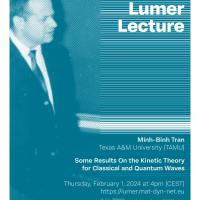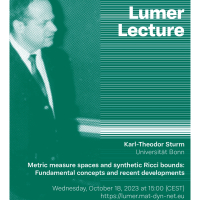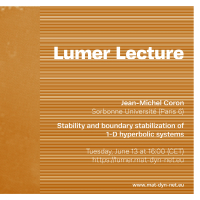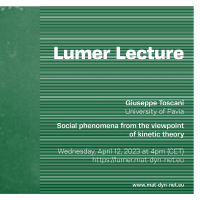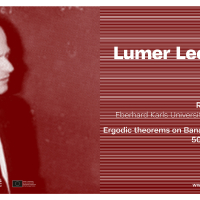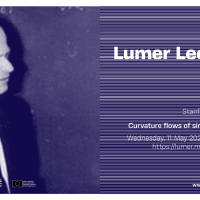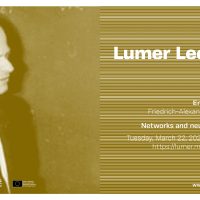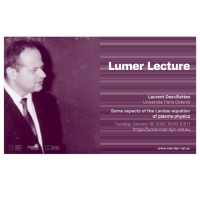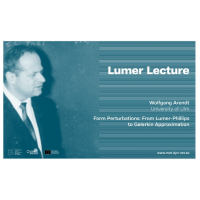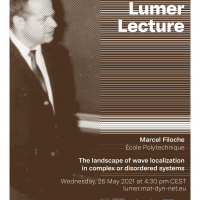Lumer lectures
This series of lectures is named after Gunter Lumer, a great mathematician with extensive achievements and a deep curiosity for applied functional analysis and operator theory, and is a joint scientific activity of all Action's Working Groups. The lectures will be delivered by carefully selected distinguished scientists whose research interests are related to our Action.
All past lectures can be viewed on YouTube.
Gunter Lumer was born in Frankfurt, Germany in 1929. With Nazism on the rise, the Lumer family left Germany in 1933 and settled in France, and then in Uruguay. Gunter graduated in 1957 with a degree in electrical engineering from the University of Montevideo, he then received a Guggenheim fellowship to study at the University of Chicago. There he received his Ph.D. in Mathematics in 1959. Although Gunter Lumer's professional focus was on functional analysis, partial differential equations, and evolution equations, he nourished a broad interest for almost all areas of mathematics and for science in general. He published more than one hundred papers and edited many books. Probably his best known result is the celebrated Lumer-Phillips theorem, which gives necessary and sufficient conditions on an operator to generate a strongly continuous semigroup of contractions on a general Banach space. This result, published in the Pacific Journal of Mathematics in 1961, is a key contribution to the theory of operator semigroups. The research areas of our Action are closely related to some of Gunter's research activities in the 80's, and also brings together many of his collaborators and students. In a sense he is at the origin of the topics developed in this Action.
More details about Gunter Lumer's life and activities can be found on the following link.
***
Thursday, 1 February 2024, 16:00 (CET)
The talk will be live streamed on YouTube.
Wednesday, 18 October 2023, 15:00 (CET)
The talk will be live streamed on YouTube.
In this survey, I will provide a brief introduction to the concept of lower Ricci bounds as introduced by Lott–Villani and myself, and illustrate some of its geometric, analytic, and probabilistic consequences, among them Li–Yau estimates, coupling properties for Brownian motions, sharp functional and isoperimetric inequalities, rigidity results, and structural properties like rectifiability and rectifiability of the boundary. In particular, I will explain its crucial interplay with the heat flow and its link to the curvature-dimension condition formulated in functional-analytic terms by Bakry–Émery. This equivalence between the Lagrangian and the Eulerian approach then will be further explored in various recent research directions: (i) time-dependent Ricci bounds which provide a link to (super-) Ricci flows for singular spaces, (ii) second-order calculus, upper Ricci bounds, and transformation formulas, (iii) distribution-valued Ricci bounds which, e.g., allow singular effects of non-convex boundaries to be taken into account.
Tuesday, 13 June 2023, 16:00 (CET)
The talk will be live streamed on YouTube.
Jean-Michel Coron has been awarded numerous prizes, such as the Fermat Prize in 1993, the Dargelos Prize in 2002, the ICIAM Maxwell Prize in 2015 and the W. T. and Idalia Reid Prize (SIAM) in 2017. He was invited as a semi/plenary speaker to the 2010 International Congress of Mathematicians, the 2015 International Congress on Industrial and Applied Mathematics, and the 2017 IFAC World Congress. He is now Professor Emeritus at the Sorbonne Université (Paris 6) and a member of the French Academy of Sciences and the Academia Europaea.
Wednesday, 12 April 2023, 16:00 (CET)
The talk will be live streamed on YouTube.
Giuseppe Toscani graduated in Mathematics at the University of Pavia in Italy in 1972. The same year he became Assistant Professor of Mathematical Physics at the same University and then in 1981 Associated Professor of Rational Mechanics. In 1987 he became full Professor of Mathematical Physics at the University of Ferrara and in 1993 at University of Pavia. From 2010, he is a member of the Accademia Nazionale dei Lincei and the Istituto Lombardo di Scienze e Lettere in Milan.
He has been a member of the Scientific Council of the National Group of Mathematical Physics
(GNFM) of Institute of High Mathematics (INDAM) of Italy.
He is author of about 250 papers and two monographs on the mathematical aspects of Boltzmann equation and of Enskog equation in kinetic theory of rarefied gases.The main scientific contributions are concerned with a) theoretical and numerical problems connected to the kinetic theory of rarefied gases, b) kinetic theory of dissipative systems with application to granular gases, c) asymptotic problems linked to the passage from kinetic to macroscopic models through both hyperbolic and parabolic scaling, d) asymptotic problems related to the grazing collision limit, and the passage to Fokker-Planck equations, e) asymptotic behaviour of nonlinear diffusion equations by entropy methods. f) kinetic models for socio-economic multi-agents systems.
In 2010 he has been appointed with a Rothschild Visiting Professorship at the Isaac Newton Institute for Mathematical Sciences of the University of Cambridge.
In social sciences, the appearance of lognormal distribution has been noticed when looking at body weight, at women’s age at first marriage, and others. Likewise, in economics, lognormal distribution appears when looking at consumption in a western society, at call-center service times and others.
The common feature of these situations, which describe the distribution of a certain attribute of agents, is the presence of a desired target to be reached by repeated choices.
In this talk, we discuss a possible explanation of lognormal distribution forming in human activities, by resorting to classical methods of statistical mechanics of multi-agent systems.
Thursday, 19 January 2023, 16:30 (CET)
The talk will be live streamed on YouTube.
Wednesday, 23 November 2022, 14:00 (CET)
The talk will be live streamed on YouTube.
Rainer Nagel received his doctorate from the University of Tübingen under Helmut H. Schaefer (Ideal Theory in Ordered Locally Convex Vector Spaces). From 1969 to 1970 he was Assistant Professor at the University of Maryland, College Park. In 1972 he received his habilitation at the University of Tübingen, where he has been Professor of Mathematics since 1975. From 1984 to 1986 Nagel was Vice President of the University of Tübingen, and in 1989/90 he was Dean of the Faculty of Mathematics. From 1993 to 1995 he was Professor of Mathematics at the University of Bari (Italy). His main research areas are functional analytic methods in the theory of linear partial differential equations (operator semigroups) and the functional analytic/operator theoretic aspects of ergodic theory. He has made significant contributions to the qualitative theory of positive operator semigroups, to the spectral theory of positive operators, to applications in the theory of partial differential equations, as well as to the general theory of strongly continuous operator semigroups and ergodic theory. Being the founding father of the TULKA Internet seminar on Evolution Equations, for which he received the Teaching Award of the University of Tübingen in 2022, with around 70 doctoral students and with his four books on operator semigroups and ergodic theory, he is one of the most influential mathematicians working on the various aspects of evolution equations.
Abstract: Banach lattices and positive operators shall be the main actors in this talk. The role they played in various areas of mathematics and their main application areas both have been changing considerably and sometimes recurrently over time. In particular they found new playing fields such as ergodic theory and dynamical systems. We review the last 50 years of this story.
Wednesday, 11 May 2022, 16:30 (CET)
The talk will be live streamed on YouTube.
Rafe Mazzeo completed his Ph.D. in mathematics at MIT under the supervision of Richard Burt Melrose in 1986. After obtaining his Ph.D. degree, he joined Stanford University, where he became a full professor in 1997. He has published more than 150 mathematics papers, and his work has been cited more than 5000 times. His work has been published in many prestigious mathematics journals, including Annals of Mathematics, Inventiones Mathematicae, and Duke Mathematical Journal. He is one of the founders of the Stanford University Mathematics Camp. He has received many awards, including a National Science Foundation Postdoctoral Fellowship, Alfred P. Sloan Foundation Research Fellowship, National Science Foundation Young Investigator Fellowship, and Louis and Claude Rosenberg Jr. University Fellowship in Undergraduate Education. In 2013, he became a fellow of the American Mathematical Society.
Abstract: This talk will describe intrinsic and extrinsic curvature flows on spaces with `well-structured’ singularities, e.g. stratified spaces. The main focus will be on the simplest case, namely the curve-shortening flow on networks of curves, which already exhibits certain new phenomena. I will describe some complications in understanding strong solutions of this flow, and some advantages relative to weaker formulations, and in particular describe a new approach to flowing out of unstable configurations. I will also describe some new stability results by other authors. If time permits, I will conclude by describing a few results and prospects for these questions in higher dimensional settings.
Tuesday, 22 March 2022, 16:00 (CET)
The talk will be live streamed on YouTube
Enrique Zuazua (Eibar, Basque Country – Spain, 1961) holds an Alexander von Humboldt Professorship at the Friedrich–Alexander University (FAU), Erlangen–Nürnberg (Germany). He is also the Director of the Chair of Computational Mathematics at Deusto Foundation, Universidad de Deusto, Bilbao (Basque Country-Spain) where he leads the research team funded by the ERC – European Research Council Advanced Grant ''DyCon: Dynamic Control''. He is also a Professor of Applied Mathematics since 2001 in the Department of Mathematics of the Autonomous University of Madrid where he holds a Strategic Chair. His fields of expertise in the area of Applied Mathematics cover topics related with Partial Differential Equations, Systems Control and Numerical Analysis.
Abstract: Partial Differential Equations (PDEs) on networks is a ubiquitous topic in applications, from multi-link elastic structures to gas distribution. We will report on some recent results and open problems in the context of optimal location of sensors and actuators. On the other hand, at present Neural Networks (NN) are being systematically being employed as a complement to the traditional methods of Applied Mathematics, to bring our simulation and control capacities beyond. But the training of the parameters of these NNs leads naturally to new control problems. This generates a rich interface between Control Theory, Machine Learning and PDEs on Networks, that we will briefly survey on.
YouTube link of the talk
After being a student at Ecole Normale Supérieure in Paris, Laurent Desvillettes received his Ph.D. in 1990 at Univ. Paris 7 under Prof. Claude Bardos' supervision, his manuscript was entitled "Mathematical and numerical study of kinetic equations from Physics". He became Full Professor in 1994, successively at Univ. Orléans, ENS Cachan and since 2015 at Univ. Paris. He provided major contributions about mathematical and numerical properties of PDEs, in particular kinetic and reaction-diffusion equations with singularities, as much as on their applications in fluid mechanics, statistical physics and population dynamics. He is author of more than 120 papers, and serves as an editor and associate editor of several international journals. Upon invitation, he did many research visits among which the ones in Italy (Rome, Torino, Parma, Pisa, Messina), Austria (Wien), Spain (Barcelona, Bilbao, Grenade), Germany (Munich, Bonn, Mannheim, Göteborg), Netherlands (Leiden), Romania (Iasi, Bucharest), Switzerland (Zürich), UK (Cambridge), USA (Princeton, Brown, Stanford, UT Austin, Courant, Maryland), Canada (Laval), Japan (Kyoto), China (Beijing), Hong Kong, Singapore.
Abstract: Landau proposed in the late 30s to model the collisions between charged particles in a plasma by a bilinear operator sharing some similarities with the Boltzmann operator of rarefied gases, but containing second order terms (and sharing similarities with the Fokker-Planck equation). We propose to explain some of the properties of this operator and of the corresponding equation (describing the relaxation towards thermodynamical equilibrium of an homogeneous plasma). We will also present the analogies of this equation with other systems appearing in mathematical physics, such as the Navier-Stokes system for 3D incompressible fluids.
Thursday, 18 November 2021, 16:30 (CET)
YouTube link with the recording of the talk
Wolfgang Arendt received his Ph.D. in 1979 and his habilitation in 1985 from the University of Tübingen, Germany. From 1981 until 1987 he was Assistant Professor at the same university, and from 1987 until 1995 Full Professor of Applied Mathematics at the University of Besançon, France. From 1995 until his retirement in 2018 Wolfgang Arendt was Full Professor and head of the Applied Mathematics Institute at the University of Ulm, Germany. He was visiting professor in USA (Berkley, Stanford), Australia (Canberra, Sydney), England (Oxford), France (Nancy), Italy (Lecce), New Zealand (Auckland), Poland (Torun). He supervised 34 Ph.D. thesis. He was awarded the Merckle research Prize in 1999. He is the author of over 140 articles and 4 books on evolution equations and spectral theory of one-parameter semigroups. He is editor and associate editor of several international journals.
Abstract: We start explaining how the holomorphic version of the Lumer Phillips Theorem leads to the theory of forms. Then we study perturbations by weakly continuous forms. We obtain essentially coercive forms which generate asymptotically compact (= quasi compact) semigroups. Elliptic differential operators and Schrödinger operators are examples where this perturbation theory is efficient.
Essential coercivity occurs also in a completely different situation: it yields a topological characterization of the universal Galerkin property. This property means that the Galerkin approximation associated with the form and an arbitrary sequence of approximating subspaces converges (and this as fast as possible).
Wednesday, 26 May 2021, 16:30 (CET)
YouTube link with the recording of the talk
Marcel Filoche received his Ph.D. in 1991 from the Université Paris-Sud Orsay. He then worked for the France Telecom R&D center, before joining the CNRS in 1997. Since 2008 he is CNRS Research Director at the Condensed Matter Physics lab at École Polytechnique. Since 2018 he is also among the PIs of a research collaboration on Localization of Waves, sponsored by the Simons Foundations. He is the author of over 180 articles on biophysics, condensed matter, and wave phenomena in mathematics and theoretical physics.
Abstract: In disordered systems or complex geometry, standing waves can undergo a strange phenomenon that has puzzled physicists and mathematicians for over 60 years, called “wave localization”. This localization, which consists of a concentration (or a focusing) of the energy of the waves in a very restricted sub-region of the whole domain, has been demonstrated experimentally in mechanics, acoustics and quantum physics. During this talk, we will present a new theory which brings out an underlying and universal structure, the localization landscape, solution of a Dirichlet problem associated with the wave equation [1]. In quantum systems, this landscape also allows us to define an “effective localization potential” which predicts the localization regions, the energies of the localized modes, the density of states, as well as the long-range decay of the wave functions. This theory holds in any dimension, for continuous or discrete systems. We will present the major mathematical properties of this landscape. Finally, we will review applications of this theory in mechanics, semiconductor physics, as well as molecular and cold atom systems.
[1] M. Filoche & S. Mayboroda, Proc. Natl Acad. Sci. (2012) 109:14761-14766.
